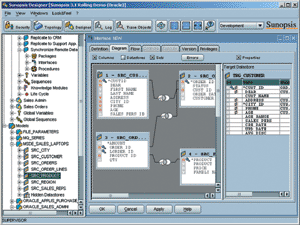Sunopsis Tool Addresses Data Transformation Performance Bottlenecks
Approximately 10 years ago when data transformation tools were being introduced into the market, RDBMS engines were not powerful enough to handle data processing and attend to other transactions at the same time. Vendors came out with their own transformation engines, which meant that most EAI and BPM processing passed through an extra tier. Sunopsis decided to stay with the database engine focus in its architecture, and the wager is now paying off beautifully.

\
MARIO MOREJON
\
Technical Editor
To have a system that is updated in realtime, information has to flow both ways in realtime. To achieve this goal, Sunopsis provides realtime processing and integration with MQ Series and TIBCO and most other high-end JMS-compliant MOM servers in the market. Sunopsis also sells Sunopsis MQ, which is a JMS server. Unlike other MOM servers, Sunopsis MQ arrives with all the configurations required to integrate with the data transformation tool.
What's more, by eliminating the extra tier between data sources and a target database, Sunopsis performs better than transformation engines that must maintain constant communication with their data sources. Even under high load conditions, databases running Sunopsis can also be used as middle-tier transformation servers. Therefore, common processing bottlenecks can be completely avoided with this architecture.
The server is priced at $29,950. Customers also have to pay for every repository they create. Each repository stores meta-data and any codes the tool generates. Typically, most customers will have a developer and a production repository.
The company provides unlimited technical support via phone, e-mail and the Web. Sunopsis provides dedicated technical support contacts for the most active systems integrators. The average solution provider margin ranges between 20 percent and 30 percent. To sell the Sunopsis suite, integrators must receive training.
The Sunopsis suite has a Java-based design tool that works in multiple environments. Since the engine is essentially the RDBMS, there is no need to have a dedicated server for a specific OS.
In the design tool, users can define the joins between various data sources without any programming. In some instances, there are modifications that have to be hand-coded when the tool does not create the desired SQL code.

After all the mapping between sources is created, users choose templates from a Knowledge Integration Module to integrate with a target database or application. At this point, users can define how to control the data and its constraints.
For instance, if filtering data is required, Sunopsis provides a Knowledge Control Module where users can inject intermediate SQL code before the transformation is processed. Regardless of the complexity behind a transformation, no programming is required to create it because the templates do all the work. Databases, flat files and XML files can be combined and manipulated without coding. Developers are required only when new templates need to be created.
Along with the design tool, Sunopsis has an orchestration tool that sends portions of SQL code to databases for execution. Sunopsis generates all the appropriate SQL code for specific databases with optimization codes included as well.
Because Sunopsis uses JDBC to connect to databases, it is virtually database- independent. One key benefit of this quality is that solution providers do not have to depend on Sunopsis every time they update their database version. However, when database vendors change critical keywords with their optimized SQL language libraries, Sunopsis changes its templates to match the new keywords. Updates can be done quickly since the company makes the code in the templates accessible to users.
Sunopsis also provides its own JDBC drivers for XML and flat files. The driver can map relational data to XML and vice versa so solution providers do not have to buy an extra tool to generate XML files from relational tables. The transformation tool can also use the internal mechanisms of a database to map relational data into a hierarchical XML structure. With this method, flat files can also be transformed into XML files.
To ease integrations of Sunopsis, the company also sells connectors for major ERPs and CRM products from vendors including PeopleSoft, SAP and J.D. Edwards.
CHANNEL PROGRAM SNAPSHOTS
>SUNOPSIS 3.2

COMPANY: Sunopsis
Burlington, Mass.
(781) 238-1770
www.sunopsis.com
DISTRIBUTORS: Direct from vendor
TECH RATING:

CHANNEL RATING:

Note: Vendors can earn up to five stars for technical merit and five for their channel program. If the average of these two scores is four stars or greater, the product earns CRN Test Center Recommended status.